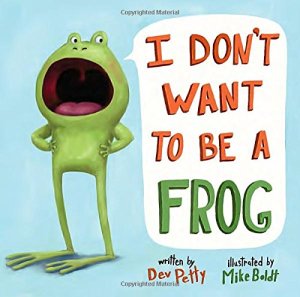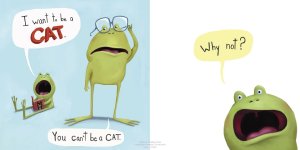Is our identity—defining it and embracing it—an avenue to an enriching existence or is it merely an evolutionary survival strategy?

Petty, Dev. I Don’t Want to Be a Frog. Illus Mike Boldt. New York: Doubleday for Young Readers, 2015. Print.
Genre: picture book
Summary: A young frog wants to be anything other than wet, slimy, and full of bugs. He wants to be a warm and cuddly kind of creature until a wise wolf shows him the perks of warts and all.
Critique: Boldt’s illustrations are wacky…or, more accurately, out-of-wacky. He uses bold strokes, bright colors stretched into dramatic disproportion. The text on the page is similarly stretched. It wasn’t clear if this style was used perfunctory (to cover more of the page) or thematically (to enhance the text with subliminal visual meanings/implications/symbols).

The narrative follows a dialogue between the young frog and his dad, whose standard answer is: You can’t be this or that; you’re a frog. Around the midpoint, poppa frog switches up the response and asks what his son does not like about being a frog. They then encounter a wolf who points out that he would never eat a wet, slimy, fly-filled frog. Bunnies on the other hand…
In general, the story felt shy of essential substance and worldbuilding. For example: wouldn’t a young frog be a tadpole/polliwog? Based on the resolution, the theme for young readers to adopt seemed to be: to become yourself or accept yourself is only an evolutionary survival strategy. Your intrinsic identity keeps you alive. I suspect it does do that, but it also does so much more.
Comments